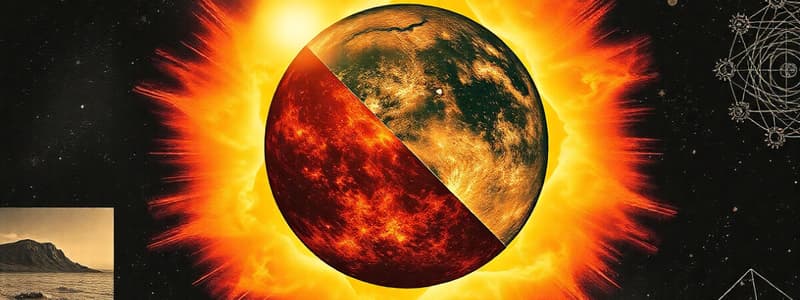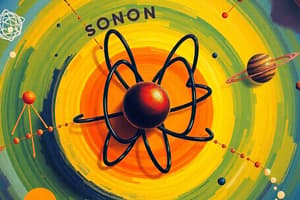Podcast
Questions and Answers
What state of matter primarily composes the Sun?
What state of matter primarily composes the Sun?
- Plasma (correct)
- Solid
- Liquid
- Gas
In which specific structure do stars, like the Sun, originate?
In which specific structure do stars, like the Sun, originate?
- Planetary Rings
- Asteroid Fields
- Galaxies
- Nebulas (correct)
Which layer of the Sun is characterized by nuclear fusion and the highest temperatures?
Which layer of the Sun is characterized by nuclear fusion and the highest temperatures?
- Corona
- Core (correct)
- Convection Zone
- Photosphere
From Earth, which layer of the Sun is directly observable?
From Earth, which layer of the Sun is directly observable?
In the radiative zone of the Sun, how is energy primarily transported?
In the radiative zone of the Sun, how is energy primarily transported?
Which solar layer is known for being the outermost and least dense, gradually transitioning into the solar wind?
Which solar layer is known for being the outermost and least dense, gradually transitioning into the solar wind?
What phenomenon on the Sun's surface is attributed to changes in magnetic fields within its convective layer?
What phenomenon on the Sun's surface is attributed to changes in magnetic fields within its convective layer?
Approximately how far is the Sun from the Earth?
Approximately how far is the Sun from the Earth?
What is the approximate age of the Sun, in billions of years?
What is the approximate age of the Sun, in billions of years?
Within what approximate temperature range does the Chromosphere of the Sun exist?
Within what approximate temperature range does the Chromosphere of the Sun exist?
Flashcards
Sun
Sun
A middle-aged, medium-sized yellow star at the center of the solar system.
Nebula
Nebula
A cloud of gas and dust where stars form.
Core
Core
The hottest part of the Sun where nuclear fusion occurs.
Radiative Zone
Radiative Zone
Signup and view all the flashcards
Convection Zone
Convection Zone
Signup and view all the flashcards
Photosphere
Photosphere
Signup and view all the flashcards
Chromosphere
Chromosphere
Signup and view all the flashcards
Corona
Corona
Signup and view all the flashcards
Sunspots
Sunspots
Signup and view all the flashcards
Distance to Earth
Distance to Earth
Signup and view all the flashcards
Study Notes
The Sun: Our Solar System's Star
- The Sun is a middle-aged, yellow star at the center of our solar system.
- It's a ball of superheated ionized gas, called plasma.
- Formed from a nebula about 4.5 billion years ago.
- Contains six layers with varying temperatures.
Sun's Internal Structure
- Core: The hottest part (27 million °F / 15 million °C). Nuclear fusion occurs here, producing heat and light.
- Radiative Zone: Photons bounce and are absorbed/emitted, taking thousands of years to travel (12 million °F / 7 million °C to 4 million °F / 2 million °C).
- Convection Zone: Heat and radiation reach the outer areas in massive convective cells (4 million °F / 2 million °C).
Sun's Outer Layers
- Photosphere: The visible surface, relatively cool at approximately 10,500 °F (5800 °C).
- Chromosphere: The Sun's atmosphere, ranging in temperature from 11,000 °F (6000 °C) to 36,000 °F (20,000 °C).
- Corona: The outermost, deepest layer. Extremely thin, but wide, extending into the solar wind (1.8 million °F / 1 million °C).
Sun: Additional Facts
- The Sun isn't the hottest star in the galaxy. Neutron star cores are significantly hotter (1.8 trillion °F / 1 trillion °C).
- Sunspot activity is linked to cyclical magnetic field changes in the convective layer.
- The Sun is 93 million miles (150 million kilometers) from Earth.
- The Sun's distance from Earth allows liquid water to exist, supporting life.
- Sunlight takes about eight minutes to reach Earth.
Studying That Suits You
Use AI to generate personalized quizzes and flashcards to suit your learning preferences.




